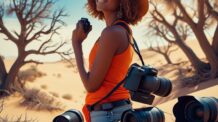Travel photography is more than just snapping landmarks and sunsets. It’s about capturing the spirit of a place — its people, colors, textures, culture, and mood. Whether you’re exploring your own country or venturing across the globe, great travel photos tell stories that last a lifetime.
In this guide, you’ll learn practical tips to elevate your travel photography and return home with a collection of meaningful, dynamic images that go beyond typical tourist shots.
Plan, But Stay Flexible
Before your trip, research your destination. Learn about:
- Key locations and viewpoints
- Local festivals or traditions
- Sunrise and sunset times
- Cultural etiquette for
- Plan, But Stay Flexible
- Before your trip, research your destination. Learn about:
- Key locations and viewpoints
- Local festivals or traditions
- Sunrise and sunset times
- Cultural etiquette for photography
- Having a plan helps you make the most of your time, but don’t over-schedule. Be open to spontaneous moments and unexpected scenes — some of the best travel photos come from wandering off the beaten path.
- Travel Light, Shoot Smart
- You don’t need to carry all your gear. Choose a setup that’s versatile and lightweight so you can move easily and stay discreet.
- Recommended travel setup:
- One camera body (DSLR or mirrorless)
- One or two lenses: a wide-angle (16–35mm) and a general-purpose zoom (24–70mm) or a prime (35mm or 50mm)
- Extra batteries, memory cards, and a lens cloth
- Lightweight tripod (optional but useful for night shots and self-portraits)
- A smaller kit encourages mobility and creativity without sacrificing quality.
- Wake Up Early and Stay Out Late
- Light is your best friend in photography — and the best light happens during golden hour (shortly after sunrise and before sunset). These times offer:
- Soft, warm light
- Long shadows and depth
- Fewer tourists in popular locations
- Blue hour (just after sunset or before sunrise) is also great for capturing cityscapes with glowing lights and a soft sky.
- Tell a Story with Your Images
- Instead of only capturing big landmarks, focus on storytelling. Think about the details, people, and atmosphere that define the place.
- Types of shots to include:
- Establishing shots (landscapes, cityscapes)
- Details (food, signs, textures, colors)
- People and culture (street scenes, market vendors, artisans)
- Candid moments (children playing, locals interacting)
- Behind the scenes (your journey, reflections, transportation)
- These images together create a visual narrative of your experience.
- Include People for Scale and Emotion
- People add life to travel photos. Including locals or fellow travelers helps show scale, adds emotion, and makes images more relatable.
- Tips:
- Use a wide aperture to blur the background and focus on expressions
- Capture candid moments from a respectful distance
- Ask for permission if taking close-up portraits
- Use a zoom lens for discretion if you’re shy or want to remain unnoticed
- Photographing people can feel intimidating at first, but it often leads to your most powerful and memorable images.
- Embrace Local Culture and Daily Life
- Great travel photography goes beyond tourist attractions. Explore neighborhoods, markets, street corners, and parks to see how people live.
- Look for:
- Daily routines like cooking, cleaning, or commuting
- Local sports, dances, or rituals
- Traditional clothing or crafts
- Candid moments that reflect the spirit of the place
- This kind of photography requires patience and respect — but it’s where real storytelling happens.
- Master Composition on the Go
- Even in fast-paced environments, strong composition makes a difference.
- Quick composition tips:
- Use the rule of thirds to frame your subject
- Look for leading lines (roads, walls, fences)
- Find symmetry in architecture or reflections
- Include foreground elements for depth
- Frame your subject through doors, windows, arches
- Be mindful of clutter and distractions. A clean composition lets the viewer focus on what matters.
- Edit Consistently
- After your trip, editing helps bring your travel photos to life. Aim for a consistent style across your images — this could be warm tones, soft contrasts, or vibrant colors depending on your personal aesthetic.
- Editing steps:
- Adjust white balance for natural tones
- Boost contrast and clarity gently
- Enhance colors without oversaturation
- Crop to strengthen composition
- Sharpen and remove any lens spots or distractions
- Programs like Adobe Lightroom or mobile apps like Snapseed are great tools for travel photographers.
- Backup Your Images Daily
- Don’t risk losing your travel memories. Backup your photos every day to multiple locations:
- Use dual memory card slots if your camera supports it
- Transfer files to a laptop or portable SSD
- Upload to cloud storage when you have internet access
- Keeping your work safe is part of being a responsible photographer.
- Final Thoughts
- Travel photography is about connection — with people, places, and stories. It’s less about perfection and more about curiosity and presence. The more you immerse yourself in the experience, the more authentic and powerful your images will become.
- So slow down, pay attention, and shoot with intention. Let your camera be a tool for discovering the world — and yourself.




Deixe um comentário